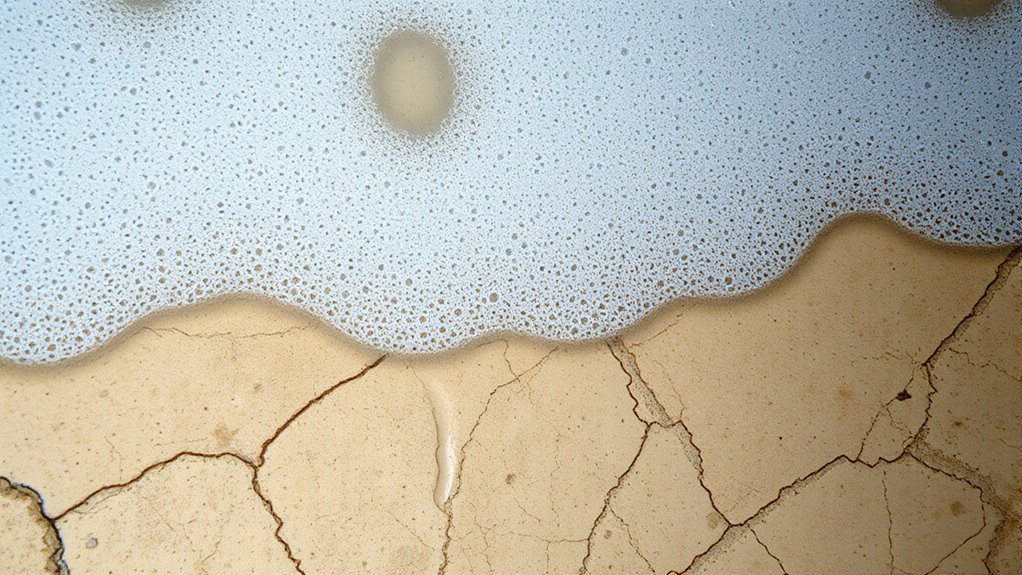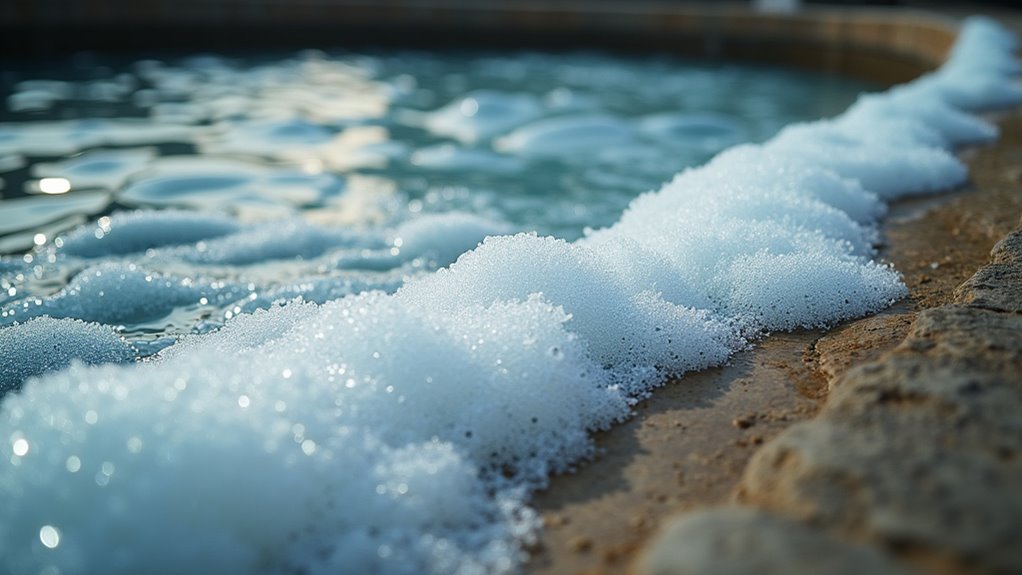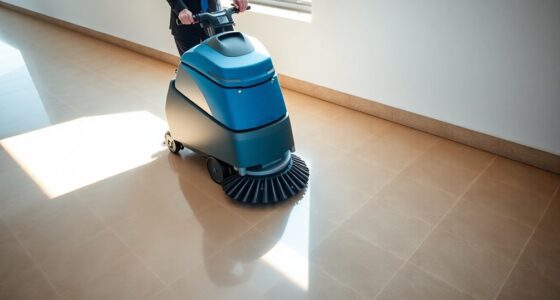Foam in your recovery tank during natural stone cleaning often results from residual chemicals or improper rinsing that create persistent bubbles. Using a defoamer can quickly break down foam and improve system efficiency. Make certain you’re cleaning and maintaining your equipment regularly, including flushing the tank and inspecting filters. Proper chemical application and routine upkeep prevent buildup and foam issues. Keep going, and you’ll discover more ways to keep your system running smoothly and effectively.
Key Takeaways
- Foam indicates residual chemicals or improper rinsing that can be controlled with effective defoamer application.
- Proper maintenance, including tank flushing and filter checks, reduces foam caused by chemical buildup.
- Selecting a compatible defoamer tailored to your cleaning chemicals ensures efficient foam breakdown.
- Using the right amount of chemical and ensuring proper dilution minimizes foam formation during cleaning.
- Regular inspection and maintenance of equipment prevent foam-related issues and improve natural stone cleaning performance.

If you notice foam forming in your recovery tank, it can indicate a variety of issues that may affect your system’s performance. Foam buildup is often caused by chemical additives used during cleaning or restoration processes, which can destabilize the surface tension of water and create persistent bubbles. Recognizing the cause of foam is essential because it directly impacts your equipment’s efficiency and the quality of your work. Foam can also signal that your system isn’t properly maintained, so addressing the root cause is crucial to prevent potential damage or operational setbacks.
Foam in your recovery tank signals chemical buildup or maintenance issues affecting your system’s performance.
Chemical additives are a common culprit behind foam formation, especially when they contain surfactants or foaming agents designed to lift dirt and grime from natural stone surfaces. While these products are effective for cleaning, they can linger in the recovery tank and generate foam if not thoroughly rinsed or neutralized. Over time, residual chemicals accumulate and lead to excessive foaming, which hampers your vacuum system’s ability to separate moisture from debris efficiently. To counteract this, you need to be vigilant about using the correct amount of chemical additives and ensuring they are compatible with your equipment. Proper dilution and application techniques help minimize leftover residues that cause foam.
Equally important is regular equipment maintenance. If your recovery tank isn’t cleaned frequently or if the filters and hoses aren’t inspected and replaced as needed, foam issues can become more persistent. Dirt, debris, and chemical residues can build up inside the tank and other components, creating a scenario where foam forms more easily and is harder to eliminate. Routine maintenance includes flushing the recovery tank after each use, checking for blockages, and ensuring all parts are functioning correctly. This prevents chemical buildup and keeps your system running smoothly, reducing the likelihood of foam-related problems.
To manage foam effectively, you should also consider using a defoamer product specifically designed for your system. These products are formulated to break down foam quickly and are safe for use with natural stone surfaces. Incorporating a defoamer into your regular maintenance routine can help control foam, especially during high-chemical-use jobs. Remember, though, that prevention is better than cure. Being diligent about chemical usage, maintaining your equipment, and performing routine inspections will help you avoid foam issues altogether and ensure your system operates at peak performance.
Additionally, understanding the importance of chemical compatibility can help you select the right products and prevent foam formation from the outset.
Frequently Asked Questions
Can Foam Damage Natural Stone Surfaces?
Foam can damage natural stone surfaces if it causes prolonged exposure or contains harsh chemicals. It may lead to etching or staining, especially if the stone’s pH balance is disrupted. To prevent this, guarantee proper stone sealing and use a pH-balanced defoamer. Regularly monitor and clean the surface to keep the stone protected and maintain its appearance, avoiding long-term damage from foam buildup.
How Often Should Defoamers Be Applied?
You should apply defoamers as needed, typically when foam becomes excessive or interferes with your process. Regularly monitor the recovery tank and observe the foam levels to determine the right timing. Proper application techniques involve adding the defoamer slowly while stirring to ensure even distribution. Keep in mind that chemical interactions can influence foam stability, so adjust application frequency accordingly to prevent overuse and protect your natural stone surfaces.
Are There Eco-Friendly Defoaming Options?
Think of eco-friendly defoaming options as a gentle rain nourishing a garden. You can choose biodegradable options and plant-based solutions that break down naturally, reducing environmental impact. These alternatives work effectively without harmful chemicals, making your cleaning process safer for natural stone and the planet. Switching to eco-friendly defoamers guarantees you protect delicate surfaces while promoting sustainability—it’s a win-win for you and the environment.
Will Foam Affect the Cleaning Process?
Foam quality can impact your cleaning process, as excessive foam may hinder effective debris removal. If foam persists, it could clog the system or lead to inefficient cleaning. Regular tank maintenance helps prevent these issues, ensuring the foam doesn’t interfere with your work. Using an appropriate defoamer keeps foam levels in check, maintaining ideal cleaning conditions and protecting your equipment from potential damage caused by excessive foam buildup.
How to Prevent Foam Buildup in Tanks?
Imagine a gentle breeze calming ripples on a pond—that’s how you prevent foam buildup in tanks. To do this, control chemical reactions and surface tension by using proper defoamers and maintaining correct chemical concentrations. Regularly inspecting your tank, avoiding over-sudsing, and ensuring proper agitation helps keep foam at bay. This way, you maintain a smooth, steady cleaning process without disruptive bubbles.
Conclusion
So, next time you notice foam bubbling up in your recovery tank, remember that a simple defoamer can often do the trick—sometimes, it’s just a coincidence that the foam appears when you least expect it. Keep an eye on your process, and don’t overlook the small fixes. After all, a little prevention and the right product can save you from bigger headaches down the line. It’s amazing how a quick solution can make all the difference.









